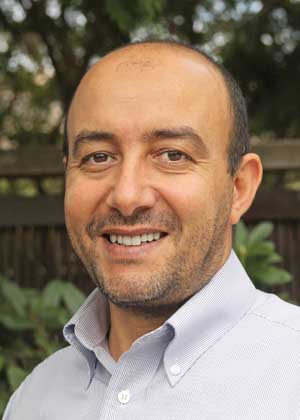
Dr. Achour Amiri
Plant pathologist Dr. Achour Amiri has joined Washington State University with the goal of helping apple and pear producers control postharvest diseases, particularly those that present phytosanitary concerns to export markets.
One of his immediate goals is to assess resistance of pathogens such as gray and blue mold, bull’s-eye rot, sphaeropsis rot and phacidiopycnis rot to available fungicides both in the field and in the packing house.
WSU has been without a pome fruit plant pathologist since Dr. Chang-Lin Xiao left almost four years ago to join the U.S. Department of Agriculture in California, so current data on fungicide resistance in Washington tree fruit is lacking.
Amiri, who is based at the Tree Fruit Research and Extension Center in Wenatchee, hopes to develop fast and reliable methods for screening resistant pathogens.
“It would be very important to know to what extent resistance has developed,” he said. “Has it spread more? Can we keep the previous recommendations or do we need to update those based on the resistance profile?”
One of the challenges for pome fruit producers in Washington is the limited number of fungicides available, particularly for postharvest use.
Resistance of blue mold (Penicillium) and gray mold (Botrytis cinerea) to thiabendazole (TBZ) has been documented, but no screening has been done for Sphaeropsis pyriputrescens and Phacidiopycnis washingtonensis, which Xiao discovered in Washington only a decade ago.
“For those two pathogens, we will be looking for ways to control them,” Amiri said. “We need to understand how they develop and how they spread and know what are the most effective fungicides against those species in order to give better recommendations to growers and packers.”
He also hopes to evaluate the efficacy of fungicide application methods, such as drenching versus fogging, and to find ways for organic growers and packers to control postharvest decays, since most of the available postharvest treatments are not approved for organic.
Amiri also hopes to develop predictive models to help growers use management strategies based on the risk of infection. A model could also help producers develop marketing strategies based on the risk that the fruit will develop diseases.
“If they know there’s a high risk with a lot, they can market it differently from a lot that has a lower risk of disease development,” he said, noting that this would be a long-term project. “It takes a long time to develop the model and implement it and make sure it’s reliable before we recommend it to growers and packers.”
Amiri was previously with the University of Florida, where he worked for four years on fungicide resistance and predictive models for disease control in strawberries.
He grew up in Tizi-Ouzou, Algeria, in an area where citrus, olives, and cherries were grown. He earned a master’s degree in plant pathology from Gembloux University in Belgium, where he studied postharvest diseases of citrus in collaboration with universities in North Africa.
He earned his doctorate in plant pathology at the University of Pierre and Marie Curie in Paris, France, where he studied pome fruit diseases, such as blue mold in apples.
In 2006, he took a postdoctoral position at Clemson University in South Carolina, where he worked on diseases of peaches and nectarines, including brown rot and armillaria root rot. He joined WSU September 1. His position is 70 percent research and 30 percent extension. •
– by Geraldine Warner






Leave A Comment